How do I use the Portfolio Summary report?
The Portfolio Summary report type is used to analyze the market value of your investments. It consists of a table that details your securities and subtotals their value by account.
Create a Portfolio Summary report
-
Choose a report type:
Click the plus (+) button on the toolbar and choose "Add Report," or choose Tools > Add New Report. iBank will ask what type of report you want:
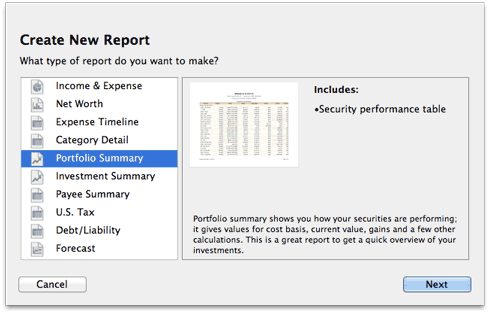
Choose "Portfolio Summary," then click "Next" to continue.
-
Choose accounts:
This screen lets you define the scope of the report by choosing which accounts are included. Using the popup menu at the top of the screen, choose one of the following options and configure its settings accordingly:
-
Limit to Specific Accounts:
By default, new Portfolio Summary reports include all accounts, whether or not they are hidden. If you want to limit the report to certain accounts, choose this option from the popup menu button and check off the accounts you want to include. When no accounts are checked, all accounts are included in the report.
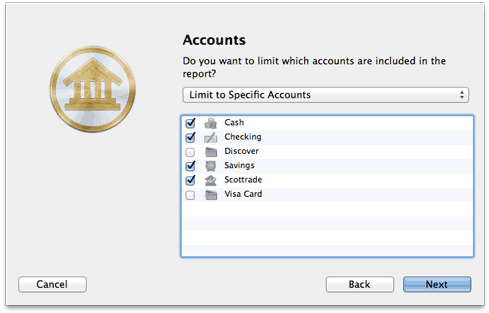
Accounts that do not contain security transactions will not be counted in the report, even if they are checked here; any banking accounts included in the report do not affect the investment data.
-
Limit to Accounts Using Smart Rules:
To limit the report to certain accounts based on dynamic criteria, choose this option from the popup menu button. You can then configure a series of rules that define which accounts are included in the report:
- Any/All of the following are true: If you choose "Any" as the option for this rule, all accounts that match at least one of the rules that follow will be included in the report. If you choose "All," only accounts that match all of the rules that follow will be included. The first instance of this rule cannot be removed. Additional "Any/All" rules can be added by holding the Option key and clicking the '...' button next to one of the existing rules. This will allow you to create more complex rule hierarchies.
- Group: Use this rule to include or exclude all accounts in a particular account group.
- Debit: Use this rule to include or exclude accounts of the following types: Credit Card, Line of Credit, Liability, and Loan.
- Currency: Use this rule to include or exclude all accounts that use a specific currency.
- Account type: Use this rule to include or exclude all accounts of a particular type.
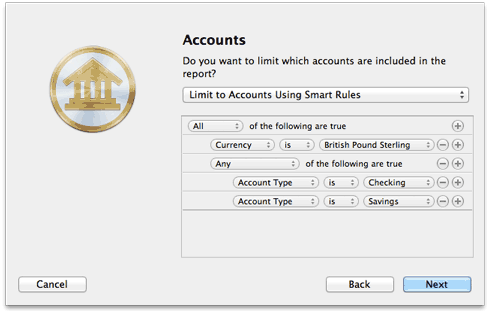
The advantage of using rules instead of checking off specific accounts is that the report will automatically update to include all accounts that satisfy the rules you set up. To illustrate, say you manage multiple investment accounts for you and your partner, and you keep them in separate account groups in the source list. You create a report to analyze only the investments in one group. Once the report has been created, you can add and remove accounts as needed, and the report will always show the investments in that particular group.
When you finish configuring accounts for the report, click "Next" to continue.
-
-
Choose a date range:
This screen lets you choose a date range for the report. Click the popup menu button and select from a variety of predefined ranges: options that end with "to Date" indicate periods of time that are relative to the current date; other options represent fixed periods of time.
Choose "Specific Start and End Dates" to define an exact range by entering two dates. You may also choose "Custom Dates" to specify a range relative to a particular date. Use the "starting/ending" popup to determine whether the report covers a range of dates in the future or past, respectively. Choose "today" to have the report start or end on the current date (regardless of when the report is viewed), or choose "on date" to specify a fixed start/end date.
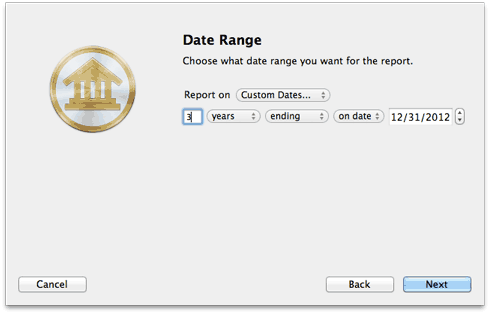
-
Finish creating the report:
This screen lets you configure a few last settings for the new report. Enter a unique name to distinguish the report from others in the source list, then pick which currency its figures should be displayed in. If accounts that use different currencies are included in the report, their figures will be converted automatically using iBank's current exchange rates.
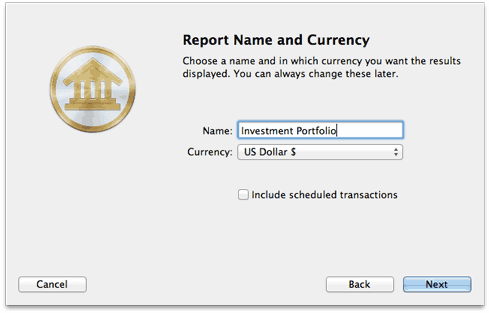
Check the "Include scheduled transactions" option to include pending scheduled transactions in addition to the transactions that are recorded in your accounts. Since investment transactions cannot be scheduled, this option will not affect the results of Portfolio Summary reports.
When you are finished configuring these options, click "Next" and then "Done." The new report will be added to the source list, and the report details will be displayed in the main window.
Edit the report settings
Once a report has been created, you can edit its settings at any time. Double-click the report in the source list, or select it and choose View > Show Popup Inspector. The report inspector will open to show you the available options. Make any changes necessary, then click "Save" to record the changes or "Cancel" to discard them.
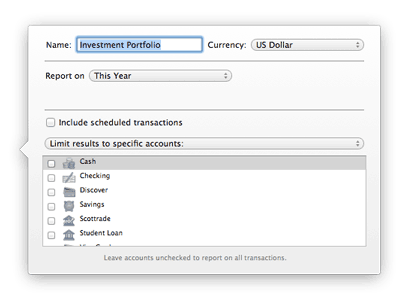
Interpret the report
The report's name and type are shown at the top of the report. The date of the report follows, along with the current market value of the shares you hold, the overall unrealized gain or loss for those shares, and the total change in value since the close of market on the previous day. After that you will see a table detailing the security shares you hold in each investment account.
Securities by Account:
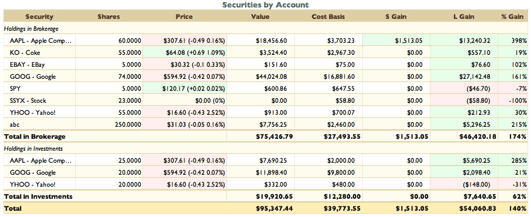
The following columns are displayed:
- Security: The ticker symbol and name of the security.
- Shares: The number of shares of the security held in a particular account as of the report's end date.
- Price: The price per share as of the report's end date, as recorded in the security's price history. The change in price since the previous day is also shown along with the percent change. Positive changes are shaded green; negative changes are shaded red.
- Value: The market value of the shares held, equal to the number of shares multiplied by the price per share.
- Cost Basis: The amount paid for the shares when they were originally purchased (including reinvested dividends).
- S Gain: The difference between the market value and cost basis, if the shares were held for one year or less. Positive values are shaded green; negative values are shaded red.
- L Gain: The difference between the market value and cost basis, if the shares were held for more than one year. Positive values are shaded green; negative values are shaded red.
- % Gain: The gain or loss on your investment, expressed as a percentage. Positive values are shaded green; negative values are shaded red.
The last row of the table shows totals across all of your investment accounts. Click on a security to view a detailed report for that security (more below). Use the arrow buttons at the top of the report to navigate back and forth as you "drill down" into the report details.
Security Detail:
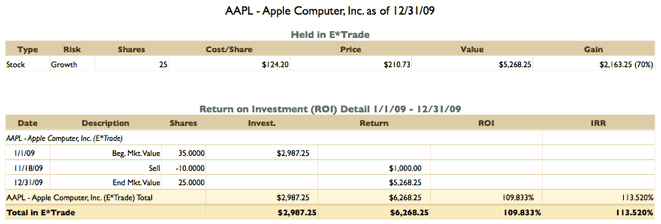
This is a report that shows detailed information about a specific security. It consists of two tables - one showing basic information about the shares you hold in that security, the other showing information about the return on your investment (ROI). The first table lists the security's type and risk level, along with several other details from the main report above: shares, cost/share (which is the cost basis divided by the total number of shares), price, value, gain, and % gain.
The second table details the transactions recorded for that security during the report's time frame, grouped by account, and uses the value of those transactions together with the beginning and ending market value of the shares to calculate the Return on Investment. ROI combines information about your realized gains, unrealized gains, and other security income into a single metric that can be used to compare the overall performance of your investments at a point in time. iBank also calculates the internal rate of return (IRR), which is an annualized rate equal to the interest rate on a bank account that would give you the same total return on your investment. Whereas ROI is useful for seeing a snapshot of your returns during a fixed period of time, IRR is useful for extrapolating your returns to other timeframes. The following columns are displayed in this table:
- Date: The date on which the transaction took place.
- Description: The transaction type.
- Shares: The number of shares affected by the transaction.
- Invest.: The amount of money invested, i.e. how much was paid in the transaction.
- Return: The amount of money earned in the transaction.
- ROI: The return on your investment, expressed as a percentage.
- IRR: The internal rate of return, expressed as a percentage.
To ensure accurate ROI calculations, be sure that the report's date range includes all transactions associated with the security shown. If part of the initial investment is outside the scope of the report, the return total will be affected.
Investment Transaction List:

This is a table detailing the investment transactions in a particular account. Only transactions that are counted in the report are displayed here; other transactions may be recorded in the account but fall outside the scope of the report. Transactions are displayed on this report in chronological order and show their dates, status, security symbols, transaction types, shares in/out, credit/debit amounts, prices per share, and commissions. A running cash balance for the account is also shown. Click on a transaction to open a new window showing that transaction in its account register. You may edit the transaction as needed; when you save your changes, the report will be updated automatically.
Print or save a copy of a report
The main report and any of the detailed reports that you can drill down to can be printed simply by choosing File > Print and clicking the "Print" button. The paper size used for the printout can be changed by choosing File > Page Setup and selecting a different setting, but the orientation is restricted depending on the report you are printing (some use portrait mode and some use landscape).
To save a copy of a report as a PDF file, choose File > Print, then click the "PDF" button and choose "Save As PDF." Enter a name for the new file, choose where you want to save it, and click "Save." You will then have a copy of the report that you can view and print using the Preview application or any standard PDF reader.
You may also export the data from any table on a report to a tab-delimited file. Mouse over the table you want to export, and a button will appear over the top left corner of the report:  Click this button and choose a location where the table data should be saved, then import the file into Microsoft Excel or Apple Numbers to use the data in a spreadsheet.
Click this button and choose a location where the table data should be saved, then import the file into Microsoft Excel or Apple Numbers to use the data in a spreadsheet.